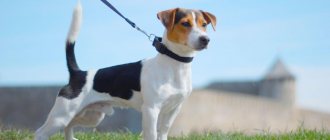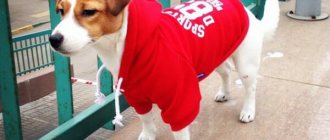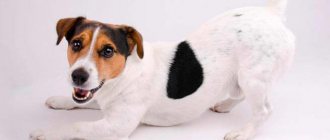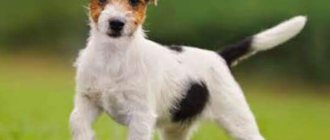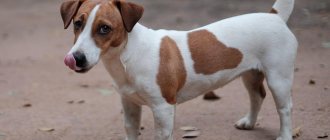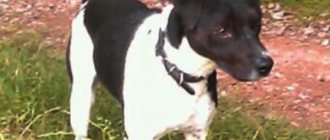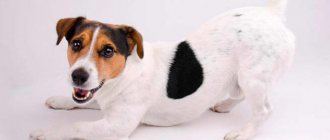Jack Russell's ears are like antennas, mood sensors. They are very mobile. With their help, you will always determine whether your pet is alert or calm, scared, or, on the contrary, happy. But, despite all their mobility, correctly placed Jack Russell ears always return to their original position, corresponding to the breed standard.
When our Jack, at the moment of changing his teeth, began to stand up like a shepherd’s, we came to the conclusion: it’s time to glue his ears!
We carefully studied the theory, because an unprofessional procedure could lead to incorrect placement of the ear. And then it's time to start practical exercises.
And today I want to tell you about how to properly glue the ears of a Jack Russell Terrier.
Interesting Facts
- July 2 is Parson Russell Terrier Day. It was on July 2, 1999 that the IFF officially recognized the breed. Dog lovers and owners get together, hold competitions or simply celebrate together.
- Parson Terriers are the best high jumpers. The current breed record is a jump of 198 cm.
- Jack Russell was not only a lover of hunting, but also of horse riding. Therefore, another criterion for the new breed was the ability to quickly and tirelessly run after a horse. This breed is named among the top ten dogs that are the best long-distance running partners.
Pros and cons of the breed
Parson Russell Terriers require a lot of attention; they are not suitable for busy businessmen, families with very young children, or elderly people.
Jack Parsons are constantly on the move and love jogging and walking. This breed is an excellent option for athletic young people with a lot of free time.
| pros | Minuses |
| Adaptability to any conditions | Naughtiness, mischief |
| Activity, cheerfulness | Uncontrollable emotions, anger |
| Developed hunting instincts | Need for serious education |
| Relentless in training and games | The breed is rare, it is difficult to find a purebred representative |
| Easy to care for | |
| Lack of shedding (in wire-haired Parson Terriers) |
Raising a loyal Parson Russell Terrier friend is not a problem. The main thing is to give your all, to love the dog as a new member of the family, to accept all the shortcomings and advantages.
Parson subtly feels all human emotions and is not stingy to give everything in full: both love and hatred.
At what age is the procedure performed?
Usually the operation is performed from the 3rd to the 10th day of the dog’s life. There are three reasons for this:
- At an early age, the sensitivity threshold is greatly reduced due to the small number of blood vessels and nerve endings in the limb.
- The puppy's tail bones are also soft, making docking easier.
- The healing process in a baby is faster than in an adult dog.
Cupping is also allowed at an older age, but no later than 6 months. At this time, the operation is painful, so anesthesia must be used. Also, the rehabilitation and healing period will be slower.
But the main risk when operating on an adult dog is anesthesia. Many dogs exhibit intolerance, and there is a high risk of cardiac, respiratory, and anaphylactic shock.
Sequencing
Before you start gluing your Jack Russell's ears, try to soften them with a massage. For several days, stretch the cartilage along the fold line.
Massage thoroughly until you feel that they have become elastic. After this, you can begin the procedure. And ask someone from your family to help - hold the puppy while you seal it .
So, prepare the necessary materials :
- plaster - it is best to use a regular adhesive plaster 2-3 cm wide;
- scissors, preferably medical, with rounded ends so as not to injure the animal;
- a five-ruble coin or a small weight.
First determine the desired fold line. To do this, take the ear by the tip and lower it to the outer corner of the eye so that it points down and forward. Don't pull too hard, just point it.
Solution
Typically, the ear cartilages in puppies begin to rise after changing teeth, at three to four months of age. Once you have discovered this, it is time to sound the alarm. Do not hope that raised ears will go down on their own - immediately make every effort to correct them.
The deficiency can be eliminated in two ways: surgically and with the help of a patch. The first method is used in especially severe and advanced cases. This operation is carried out in veterinary clinics by experienced specialists, and we will not write about it.
The second method is to seal the ear cartilages with adhesive tape. It is completely safe, accessible to everyone and does not injure the animal. The bandage will smooth out unwanted folds on the ears and lower them down.
And do not forget to consult with your breeder first - he knows the genetic characteristics of your dog, and his advice will be valuable to you.
Is it safe?
Properly performed gluing does not cause any harm to the dog. However, if the owner does not have experience, it is better to entrust the first gluing to your breeder or another specialist who has experience working with this breed. Since the procedure is repeated many times during the change of teeth, over time the owner will learn to do it independently and the need for specialist intervention will disappear.
Some of the most common side effects and problems include:
- Allergy to the patch in a dog;
- Excessively tight ear;
- Fixation of ear position that does not correspond to the breed standard;
- The appearance of irritation and bacterial infections;
- Painful sensations caused by a patch or glue in the ear when they are removed.
Advice! At first, keep a close eye on your puppy. An attentive owner will promptly detect the appearance of a characteristic unpleasant odor, anxiety of the puppy, itching and redness. These symptoms are a sign of developing inflammation and require immediate removal of the patch and healing of the painful area.
Are there any contraindications?
There is no reason not to dock a Jack Russell's tail. But if the dog feels unwell, it is better to reschedule the operation. It is recommended to postpone the procedure when:
- the dog is drowsy, lethargic and lacks appetite;
- puffiness or swelling appears on the body;
- there is atypical discharge from the mucous membranes of the nose or eyes.
The only contraindication to docking is the age of the animal. The operation should not be performed on old dogs. The subcaudal artery, through which blood flows to the tip of the tail, is quite large. The older the dog, the more effort it will take to sew it up. And post-traumatic swelling increases the already strong tissue tension.
As a result, the risk of suture dehiscence and subsequent bleeding increases.
Dog's name
A dog named Milo demonstrated not only the power of a dog's devotion, but also showed remarkable ingenuity in the movie scene with the keys. The clever craftsman who played the role of Stanley Ipkiss's little friend was named Max.
It's surprising that the viewer was not deceived. For example, the famous Lassie was played by male actors. Among the interesting facts inherent in the four-legged actor or his brothers in the breed, the following should be highlighted:
- Emotionality Animals quickly become attached to their owners and express any feelings with the help of a loud bark.
- Jumping Jumping 150 cm in height is a favorite pastime of terriers. It is important for the owners to mentally prepare for his athletic tricks.
- Max's experience Terrier managed to appear on the big screen back in 1991 in the role of the funny Gryzlik from the film “Problem Child”.
- Fearlessness Miniature size does not play a role in times of danger. The dog always shows persistence and is not inferior to larger breeds.
- Immortalized memory of the founding father The first breeder and subsequent founder was the Englishman Russell John.
- Love of digging The hunting spirit of their ancestors allows them to dig deep holes in a short time, so they love to dig in their personal yard.
- Mystical coincidence with the director's last name Chuck Russell definitely didn't cast based on his own last name, but the final result casts doubt.
- Longevity Milo lived a long and happy life. Having left the world at the age of 16, he left a reliable replacement in the person of his son Enzo.
Frank Welker, who is remembered for his roles as the monkey Abu and the charming chubby Garfield, was responsible for the voice acting.
How to choose the right puppy
Parson Russell Terrier puppies are practically no different from Jack Russell babies. Small dogs are identical until 9–12 months, when the difference in size and build becomes noticeable. Because of this similarity, inexperienced dog breeders purchase crossbreeds, and scammers easily pass off one breed as another.
Some prefer to take teenagers (6-7 months) in order to see external qualities, advantages and disadvantages, because by this age babies acquire the features of adult dogs.
In order not to make a mistake with your purchase, you need to contact the official breed nursery.
Unfortunately, in Russia there are few breeders involved in breeding Parsons; Jack Russells are more popular.
Important! All kids should be clean, active and healthy. Passivity, lack of reaction to a stranger is a pathological sign.
Vaccinations and susceptibility to disease
Vaccination is the only method of preventing dangerous viral diseases that the dog’s immune system is not able to cope with. Vaccination begins early, at 2.5 months. Then the puppy is injected with strains of distemper, enteritis, hepatitis, and parainfluenza. After 2-3 weeks, the vaccination is repeated, adding leptospirosis.
At 6–7 months they are vaccinated against rabies. All vaccinations are repeated annually to prolong the effect of the drug.
The Parson Russell Terrier breed is considered one of the healthiest dogs in the world. She does not have heart or gastrointestinal problems or neurological spectrum disorders. But dogs are not without genetic diseases.
The main problem is necrosis of the femoral head. It appears by the age of 5–6 years. The common name of the disease is Legg-Peters disease.
Congenital deafness is less common. It is typical for individuals with a pure white coat color.
Important! A congenital disease that can be seen in puppies is a lack of coordination of movements. It is incurable and is characterized by disorientation in space and chaotic movements.
Postoperative period
Typically, tail docking is easy and without complications. Already on the second day after the procedure, the puppy is cheerful and active again. Adult dogs may become restless by licking the amputation site. But this does not in any way affect their usual daily schedule. There is no need to change the diet; the wound is a minor injury that heals quickly in dogs.
However, there is a risk of encountering some complications:
- Bleeding. The older the dog, the higher the risk. If the wound bleeds, it must be treated with streptocide or a 5% alcohol solution of iodine. It is also advisable to bandage the tip of the tail for 12-24 hours. An additional protection is provided by a collar that will prevent licking and removal of the medicine.
- Inflammation of the sutures. Occurs when sterility measures are not observed during cupping, sutures come apart, also when the dog’s immunity is low or the presence of subclinical infectious diseases. You can treat the inflammation area with iodine, but it is better to entrust the treatment to a specialist.
If complications arise, the surest way out is to consult a veterinarian. A specialist will always be able to determine the treatment method more accurately and correctly.
Why do Jack Russell ears go up?
In principle, there is no clear answer to the question of why jacks’ ears rise. This depends on many factors: on the level of calcium in the blood and food, on age-related changes in the puppy during the period of teeth change, on the vaccination given to the puppy and many other reasons.
But the main thing is genetic predisposition. Recently, the Jack Russell Terrier breed has lost its true purpose - hunting. During the appearance of this breed, dogs were actively used to drive the animal out of its hole. And therefore they needed hanging ears to prevent dust and dirt from getting into them.
Nowadays, the dog is no longer a hunting dog, but a house dog. Therefore, the ears began to lose their “hangingness”. But a breed standard is a breed standard. And therefore, this criterion is one of the most important and evaluated at exhibitions. Jack's ears must be of the correct shape. And, if you are going to participate in exhibitions and want your pet not to be disqualified, from a very early age and up to nine months, you should pay close attention to his ears.
Why do a dog's ears go up?
The reasons are different:
- genetic predisposition;
- excess calcium in the blood;
- change of teeth;
- vaccinations;
- many other factors.
Important: it should be taken into account that erect ears in a Russell Terrier are considered a major drawback. Such a dog is disqualified from exhibitions and is not allowed for breeding. Therefore, you need to notice this flaw in time and take measures to correct it.
How to properly glue your ears
Next, we will consider several ways to correct the position of the ears. All of them do not pose any danger to the health of the pet. But keep in mind that they also do not provide a 100% guarantee. Very often, glued ears that have acquired the correct shape begin to rise again.
The process of correctly positioning the ears is long and labor-intensive. In addition to gluing the ears, you also need to constantly massage the ear cartilage. You need to massage the ears along the fold line that you determine.
You need to massage millimeter by millimeter, thoroughly kneading the cartilage so that it softens and becomes elastic. This will make the process of sealing your ears more effective.
There are also ways to correct ears using surgical interventions, but we will not talk about them. They are performed only in extreme cases and by a sufficiently experienced veterinarian.
So, in order to adjust Jack's ears, you will need:
- A high-quality medical plaster with a width of at least 2-3 cm.
- Scissors.
- Five-ruble coin.
It is better to carry out all manipulations together, so that one person helps to hold the fidget, and the second carries out the necessary actions.
Method one
Suitable for ears that are starting to stand up like a shepherd's. Bend the eyelet to determine the correct fold (fold line). To do this, take it by the tip and bring it closer to the outer corner of the puppy’s eye. There is no need to pull it hard, trying to bring it to the eye. It is enough for the tip of the ear to be in line with the outer corner of the eye, pointing clearly forward and looking down. This is the correct bend line, which we will focus on.
Next, first stick the patch on the outside of the ear, leaving a 1-2cm margin at the edges. The gluing line should be the previously defined fold line. But you need to glue not exactly along it, but slightly retreating a few millimeters down.
Make sure that no folds form under the patch. Before gluing, carefully straighten the ears of the jack.
Then, we repeat all the same steps on the inside of the ear.
Since one layer of bandage will not be enough, it is necessary to make several such layers, ensuring that the correct fold line is maintained and there are no folds. To make the bandage heavier, you can place a coin between its layers. Then carefully trim off the excess patch along the edge of each ear.
This is what we should get.
During the first days, your fidget will try in every possible way to get rid of the bandage that is bothering him. He will vigorously shake his head and scratch it with his hind paws. Calm him down, distract him with toys. And then all your torment will not be in vain.
Method two
To correct creases in the ears. This method is aimed at correcting creases and unnecessary folds to which the ears of Jacks are prone. To do this, you need to lift your pet's ear by its tip into a standing position. We glue the patch on the inner surface of the ear, along its entire length (from the very base to the tip). One strip of adhesive will not be enough, so apply 2-3. So, we got a standing ear.
Next, as in method No. 1, we conditionally determine the fold line and bend the ear of the quadruped along it, holding this bend for some time (10-15 minutes) so that the patch forms an internal fold and forces the ear to be in this position.
But do not overdo it with layers of adhesive, otherwise the ear will rise. If this happens, you should remove the excess layers of the patch.
After the manipulations, the correct shape of the ear should be like this.
Method three
Reinforced. This method is suitable for puppies who are especially eager to get rid of the ear sticking described in the first two methods.
We glue a patch to the inner surface of the tip of each ear. We glue it not lengthwise, but across it, leaving 1-2 cm of margin.
Next, the assistant must bend and hold the jack's ears in the correct position. At this time, you take a single piece of plaster and, starting from one ear, across the forehead, reaching the second ear, carefully glue the puppy’s head. Both ends should stick well due to the additional “reserves” of the patch that are left at the edges. Next, we pull the patch further, gluing it at the junction of the neck and jaw, and return to the first ear. We fix the patch by closing the ring. Our dog looks like he has a bandaged head.
Triming as the main part of grooming
Trimming your Jack Russell Terrier is a key aspect of grooming. It is not needed for the smooth-haired type, but is required for Brokens and Roofs.
Trimming refers to the grooming procedure of removing dead and matted fur - manually or with special tools. Essentially, this is plucking out old hairs. The procedure is necessary for all wire-haired dog breeds, because... they do not shed their coats themselves. Moulting for “jacks” is replaced by manipulation.
Without trimming, your pet's fur will grow long, become matted, yellow and dirty - in the photo, “Jacks” with unplucked hair look like mongrels. Hair renewal and blood circulation are also disrupted, and skin diseases are possible due to the accumulation of fat, dirt and impaired ventilation.
Trimming is carried out manually or with a special tool - a trimming knife or stripper. Because It is difficult to pull out hairs; rubber tips are placed on the fingers to prevent injury.
Trimming is painless, but uncomfortable for the dog. Therefore, she may whine and struggle.
The trimming technique is the same for both types of breed. However, the Brocken Jack Russell Terrier needs it once every six months, and the Roof needs it every 3 months. Show dogs have their fur trimmed every 1 – 1.5 months.
General rules
It is better to have it trimmed at a pet salon. But, if you get the hang of it, you can do it yourself. The procedure is carried out as follows:
- Jack Russell Terrier dogs are placed on the table. It should be up to the owner’s waist for comfortable work.
- Fix the pet. A leash is placed around the dog’s neck and the latter is tied to a hook or holder located on top of the table. If the Jack is prone to biting, a muzzle is required.
- They begin trimming from the body - from the withers to the tail. Then they pluck half of the head on the right or left, the front and back paws on the same side. After the second part of the body on the other side.
- The last thing they do is the face. First, the hair is removed from the back of the nose, then a beard and mustache are formed. They are plucked out completely, except for the whiskers. The head is plucked by hand so as not to scratch the dog with the stripper.
- The fur inside the ears, on the stomach and near the anus is not plucked, but trimmed with a clipper with a fine attachment.
- Pluck the fur coat evenly, avoiding bald spots.
Only a few hairs are captured at a time. Otherwise, they will be plucked unevenly and painfully.
The wirehaired Jack before and after trimming is radically different. The procedure lasts from 1 to 4 hours. This is a long time, but the manipulation must be completed at once, otherwise the fur coat will have time to grow before the next time and will look uneven.
- before the procedure, do not bathe the “jack” - dirty fur is easy to grab with your fingers, while clean wool slides;
- after the manipulation, the dog is dressed in overalls so that he gets used to the ambient temperature without a thick fur coat;
- Upon arrival home, wash the dog with warm water from the shower to wash off the hairs.
For several days after grooming, your pet may itch or shake its head. If there are no rashes or irritations on the skin, and the ears are clean, this is simply a reaction to the procedure, which will soon pass.
First time
The first trimming for puppies is carried out on average at 4 months, when the baby fluff is replaced by an adult coat. But each Jack Russell Terrier dog grows and develops individually, so the dates are shifted by 4 weeks forward or back.
To determine that a puppy needs coat grooming, run your hand along the back; if you feel the guard hairs tingling, it’s time for your pet to go to a pet salon.
The first time is important. They trust the “jack” to a trusted specialist - he will calm the baby and perform the procedure painlessly. If you scare the dog or hurt him, in the future the pet will be afraid and resist with all four paws.
Grooming Jack Russell Terrier
We start with this procedure. Since it involves a full range of work on caring for the pet’s fur, including trimming.
What does grooming include:
- Wool washing, drying, styling;
- Maintaining the coat in the structure necessary for the terrier, forming the correct position of the coat - trimming;
- Haircut with a clipper or scissors;
- Individual selection of cosmetics for a dog, taking into account the structure of the pet’s coat and skin.
Grooming a Jack Russell is the same as cutting a dog's hair. But, taking into account the specifics of the breed, only the hair on the tail, paws, neck and butt is trimmed. Jacks cannot be completely trimmed.
What is Jack Russell trimming?
Literally, trimming is the removal of old, dead hair that is no longer alive, but is still held on the body by the dog’s coarse fur. Wire-haired breeds, such as the Wire-haired Jack Russell, do not have a natural coat change, simply shedding. Therefore, it is necessary to remove dying hair manually regularly.
Trimming allows new hair to grow naturally and also stimulates blood circulation in the skin.
After some time after trimming, your pet's coat will look lively and elastic. And the hair will become shiny and flexible. Dirt sticks to such fur much less, thorns do not cling, and if your pet gets wet, it will dry quickly.
Trimming for allergies
Don’t be surprised, but trimming rids the dog of the allergen contained in dead skin flakes. As a result, the regularity of the procedure will save both the owner and the animal from hassle.
Since trimming is carried out entirely manually, it is difficult for beginners to cope with this procedure. This requires experience and skill.
To ensure that the dog is comfortable and trimming does not cause pain, the master determines by touch whether the animal’s fur is ready for the procedure.
First trimming
First trimming of a Jack Russell Terrier: Photo 1.
You can start trimming a Jack Russell for the first time at approximately 3 months of age. And in most cases this is done by the breeder. Thus, gradually teaching the puppy not to be afraid of this procedure.
But in the future, the Jack Russell Terrier must be trimmed by a specialist. Before going to the groomer, do not bathe Jack, as dirty wool is easier to trim. After the procedure, be sure to bathe the terrier with hypoallergenic shampoo in warm water to remove any remaining hair flakes.
Without experience, you can harm the coat and skin of the Jack Russell Terrier. As a result, the appearance of the coat will deteriorate for a long time until it grows back completely along its entire length.
Haircut or trimming?
Trimming is a procedure for all Jack Russells, regardless of whether they are a show dog or not.
Jack, as we have already said, cannot be cut. This will ruin the animal's coat, making it soft and weakened.
The Jack Russell's coat is elastic and coarse. When it is pruned, then it will start to grow from its thin part at the base. And if you pluck it, the hair grows back with the same hard tip.
Jack Russell: Grooming
Caring for the coat of Jack Russell Terriers depends on what type of coat your dog has. Let's figure it out.
Grooming the smooth coated Jack Russell Terrier:
For smooth-haired terriers, a stripping procedure is carried out during seasonal molting. If the dog lives in a house, it will shed twice a year. In the apartment, the smooth-haired Jack sheds all year round.
Stipping - artificial shedding, removal of guard hair and undercoat. After stripping, the animal's hair is renewed. Smooth-haired Jackcrassels are stripped regularly, every 2-3 months. If the dog lives in an apartment - once a month.
Unlike trimming, you can do stripping yourself. For this you will need a furminator - a comb in the form of a metal rake.
Grooming the Brocken and Wirehaired Jack Russell Terrier:
Dogs with this type of coat shed unnoticed, leaving almost no hair in the apartment. This is because dead hair remains on the body. Over time, the dog takes on an unkempt and shaggy appearance, and the coat quickly becomes dirty and becomes tangled.
To help the animal get rid of old fur, regular trimming is needed. The coat renewal cycle is 4-6 months.
Trimming and grooming Jack Russell Terrier. Photo 2
To prevent Jack Russell from worrying and stress during trimming and grooming, be sure to accustom him to these procedures while still a puppy.
The correct ear shape of Jack Russell Terriers
Since Jack Russell Terriers are burrowing dogs, their ear flaps must protect their ears from dirt. This means being semi-erect, slightly raised on the cartilages.
According to conformation requirements, Jack Russell ears should hang forward and fit close to the head, with their tips positioned as close as possible to the outer corner of the eye.
According to the standard, the ears have only one fold line, located on the same straight line with the level of the dog’s head.
Be sure to read the Jack Russell Terrier breed standard
This ear position is formed in puppies up to the age of 6-8 months. Until this age, and especially during the period of changing teeth, the puppy’s ears can “walk”, that is, rise slightly on the cartilage or move to the side.
However, you need to start monitoring the shape of your pet’s ears much earlier – from about 3 months of age.
If at this age the puppy’s ears stand up or take an incorrect position, in which the ends of the ears are directed to the sides, correction should begin as soon as possible.
Care and maintenance
You can keep a Jack Parson Terrier both at home, indoors, and in the local area - in a kennel.
The dog will not adapt to a chain or enclosure; the best option for a Jack Parson is the ability to go out into the yard at any time. But even in city apartments, dogs get along well.
Parson Russell Terriers are unpretentious in food and care. Such pets don’t need much; for them, heaven is in a hut if there is an owner nearby. Well, the owner must take care that the pet is healthy and cheerful.
The right diet
The choice between dry ready-made food and natural food is up to the owner of any dog, and the owner of the Parson Russell Terrier will also have to decide for himself. There are pros and cons to any type of nutrition.
Representatives of the breed do not suffer from allergic reactions, but it is better to make a choice in favor of expensive super-premium food, which does not contain dyes, preservatives, starch and wheat. The granules should be medium in size. Calorie content is medium or high - for active dogs.
Natural food is always healthier than dry food, but it requires time. The owner will have to independently select and prepare food and prepare a diet.
Meat (chicken, lean beef, lamb) is not boiled, but doused with boiling water.
Cereals (oatmeal, buckwheat, rice) are boiled in water - broths do not benefit dogs. Fruits and vegetables (apples, carrots, beets) are boiled along with porridge or given raw. You can supplement the protein part of the Jack Russell's diet with kefir, cottage cheese, and sea fish.
Choosing tail length
There is no concept of “standard tail length” for this breed. Previously it was believed that the classic size for the Jack Russell was 4 inches (10.6 cm). It is a myth. The optimal tail length depends on the size of the dog. The main thing is that it looks harmonious with the terrier's body.
To be fair, it is worth noting that a tail that is too short (when 4-5 cm does not fit on top of a clenched palm) is considered a disqualifying fault. Usually, when determining the cut-off line and predicting the size of an adult Jack Russell Terrier, breeders rely on the data of the parents.
Useful tips and opinions from veterinarians
The tail plays an important role in animal communication. According to research by Canadian scientists on the behavioral reactions of dogs with changes in the tail, even the amplitude of its movements is an important signal. This is how animals determine whether to approach each other, what mood the opponent is in, and whether he poses a threat.
Doctors agree that docking a dog's tail is purely aesthetic. By deliberately injuring a pet, the owner reduces the possibility of conflict-free and meaningful communication.
When gluing the ears of a Jack Russell, it is important to ensure that diaper rash does not form on the skin. If they are found, remove the bandage and let your pet rest for a couple of days. It is advisable to wipe the inner surface with salicylic alcohol to stop the spread of bacteria.
What is ear reshaping?
Ear correction is an intervention that will result in the dog's ears taking on the correct shape.
There are two types of correction - surgical and mechanical.
- Surgical correction is carried out only by a specialist, a surgeon. It is performed in especially advanced cases when it is impossible to give the dog’s ears the desired shape by other means.
- Mechanical correction – involves gluing the ears with adhesive tape.
This correction is absolutely safe for the dog, does not cause it pain, and will lead to the rapid formation of the desired shape of the ears.
If your puppy is not yet 8 months old and the shape of his ears does not differ too much from the required one, mechanical correction of the ears is recommended.
Materials
There are several methods for gluing ears:
- Using a patch;
- Using glue;
- Using weighting objects;
- With the use of auxiliary devices.
Before putting your Chihuahua's ears on, it is important to check your dog for allergies. If the patch material is not suitable, other materials can be used. This is for example:
- Surgical breathable tape;
- Reinforced construction tape;
- Masking tape for painting cars. Breeders recommend Italian.
Alternative materials are less sticky, easier to remove and more rigid, but are not always available.
Basics of the procedure
There are two ways to install ears: surgical and mechanical. Surgical intervention using injections is necessary only in emergency, advanced cases. The second method will not bring any pain to the Jack Russell Terrier. In order for your pet's ear placement to be successful, you first need to massage the ear cartilages along their fold line for several days. The massage must be thorough so that the cartilage acquires elasticity. Procedures must be carried out as often as possible - as many times a day as you can.
When you understand by palpation that the ear cartilages have softened, you can begin to glue them.
To do everything properly, prepare the following items in advance:
- adhesive medical plaster two to three centimeters wide;
- sharp scissors;
- weight - a coin or something similar.
It is worth noting that the Jack Russell Terrier is a very active dog, so it will be better if one of the family members helps you. He will be able to hold your pet while you glue the ears.
First option
This method is suitable for a dog whose ears are like a shepherd's.
First of all, you need to bend your pet's ear so that its tip points straight down. It should be level with the outer corner of the Jack Russell Terrier's eye. In this position, the fold line you need will appear.
Now cut a piece of tape slightly larger than the width of your dog's ear. You need to glue the patch on the outside, focusing on the fold line, parallel to it, but slightly lower. Don't forget to straighten the ear well, otherwise wrinkles will form under the patch.
- Pepper patch for arthrosis
Lift the Jack Russell Terrier's ear and repeat the same steps on the inside. Since one layer will not be enough to make it heavier, you will have to glue a sufficient number of layers of plaster - about three or four. Use a five-ruble coin as an additional weight, gluing it between the layers.
During the procedure, carefully ensure that the fold line remains the same and there are no folds. When finished, be sure to trim off the excess patch, otherwise your pet will be able to pull off the structure.
Second option
This method will help you get rid of irregular bends on the ears of your Jack Russell Terrier.
First of all, you need to lift your pet's ear by its tip so that it takes a standing position. From the beginning of the ear to the end, you need to glue several layers of adhesive on its inside. This way, the dog's ear will be fixed in a standing position.
Now we determine the correct fold line, as we did in the first example. Now you need to keep the Jack Russell Terrier's ear in this position for about fifteen minutes. As a result, it should remain in the correct state.
If, after you release your dog's ear, it becomes erect, then you have applied too many layers of tape. We'll have to remove the excess.
Third option
The Jack Russell Terrier will have to wear any of the designs until his ears take the required shape.
Remember to take a three-day break every seven days. If you do not remove the patch, diaper rash will appear on the skin, which will lead to inflammation. To prevent irritation, you can place a piece of medical bandage under the patch. If trouble does occur, wipe the affected area with salicylic alcohol. It will prevent the entry of various infections.
If your pet does not want to put up with your actions and constantly rips off the structure, you will have to use an enhanced method of ear placement.
First of all, we glue the patch along the inside of each dog’s ear, with a margin of two centimeters.
- Pepper plaster for runny nose
Now your assistant should bend the Jack Russell Terrier's ears correctly. And you need to glue the patch around the dog’s head so that the ears are fixed in the desired position - across the forehead, securing it under the neck. The tips of both ears should be supported by a supply of tape.
Be patient, distract your pet from the structure with active play with his favorite toys, and all your efforts will be rewarded with the correct positioning of your dog’s ears.
How to care for your bandage
The dog should walk around with its ears taped for at least a week. Then, to prevent diaper rash, the bandages are removed and the puppy is allowed to rest for 3-4 days. Afterwards the bandage is applied again. These steps are repeated until the ear cartilages acquire the correct shape.
Important: to avoid diaper rash, place a piece of bandage or gauze under the patch on the inside of your ears. If they do appear, treat these areas with salicylic alcohol.
If you are patient and persistent, your efforts will be rewarded - the Russell Terrier's ears will become magnificent . The main thing is not to waste time, otherwise raised ear cartilage will no longer be corrected.
Jack Russell Terriers are cheerful, energetic dogs who love walking and active pastime. Caring for them is easy. However, like all terriers, these dogs have a determined and independent character, and can sometimes be difficult to handle. But by showing persistence and patience in training, you will gain a loyal and reliable friend.
How to glue the ears of a Jack Russell Terrier
To glue the ears of Jack Russell puppies, a medical plaster is used, which must be wide and sticky enough to hold the ear well in the desired position.
Typically, a 2 cm wide patch is used. We will look at three correction methods using a patch that will help give the dog's ears the desired shape in the most common cases.
Before you start gluing your puppy's ears, it is recommended to devote several days to regular massages of the ears in the places where the folds are supposed to be. You need to massage thoroughly in order to properly warm and soften the ear cartilage, but so as not to cause pain to the dog. Try to get massages as often as possible.
After 3-4 days of such regular massages, you can start gluing your ears.
Tags
Jack Russell TerrierJack Russell TerriersJack Russell TerriersJack Russells.Jack Russell TerriersJack Russell TerriersJack Russells shouldJack Russell TerrierJack Russells stand upJack Russell Terriers The ears of dogs of this dog or the heads of a dog. Your dog can the ears of the dog the ears of the dog the desired ears of the dog the desired cause pain to the dog. In dogs usually many dog breeders are repelled by the Jack Russell breed. Jack's ears ears Jack Russell Jack Russell Jack Russell Jack Russell Since Jack Russell Jack Russell breed Jack Russell
read wool

